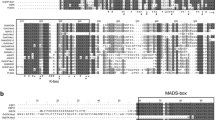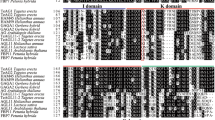Abstract
An AGAMOUS (AG)-like gene, GbAGL2, was isolated from Gossypium barbadense and characterized. Alignment and phylogenetic analysis indicated that GbAGL2 shared high homology with AG-subfamily genes and belonged to a C-class gene family. DNA gel blot analysis showed that GbAGL2 belonged to a low-copy gene family. Reverse transcriptase-polymerase chain reaction (RT-PCR) and quantitative real-time PCR (qPCR) revealed that GbAGL2 was highly expressed in reproductive tissues including ovules and carpels, but barely expressed in vegetative tissues. In addition, GbAGL2 expression in a cotton cultivar XuZhou142 (wt) (XZ142, G. hirsutum L.) and its fibreless mutant XZ142 (fl) was examined. RNA in situ hybridization analysis indicated that GbAGL2 transcripts were preferentially restricted to outer ovule integuments, carpels and fibres. These expression patterns implied that GbAGL2 might participate in the development of the carpel and ovule. Furthermore, Arabidopsis transformation was performed and modifications occurred in flowers, and the silique length of transgenic plants also increased slightly, suggesting that the GbAGL2 gene may have a positive effect on the development of the ovary or ovule. Our findings suggest that GbAGL2 might not only specify the identity of floral organs but also play a potential key role in ovary or fibre development in cotton.
Similar content being viewed by others
Abbreviations
- AG:
-
AGAMOUS
- bp:
-
base pair
- dpa:
-
days post anthesis
- fl:
-
fuzzless-lintless
- RACE:
-
rapid amplification of cDNA end
- qPCR:
-
quantitative real-time polymerase chain reaction
- RT-PCR:
-
reverse transcription PCR
- SEM:
-
scanning electron microscopy
- Wt:
-
wild-type
- XZ142:
-
XuZhou142
References
Basra A and Malik C P 1984 Development of the cotton fibre; Int. Rev. Cytol. 89 65–113
Bowman J L, Baum S F, Eshed Y, Putterill J and Alvarez J 1999 Molecular genetics of gynoecium development in Arabidopsis; Curr. Top. Dev. Biol. 45 155–205
Bowman J L, Drews G N and Meyerowitz E M 1991a Expression of the Arabidopsis floral homeotic gene AGAMOUS is restricted to specific cell types late in flower development; Plant Cell 3 749–758
Bowman J L, Smyth D R and Meyerowitz E M 1991b Genetic interactions among floral homeotic genes of Arabidopsis; Development 112 1–20
Bradley D, Carpenter R, Sommer H, Hartley N and Coen E 1993 Complementary floral homeotic phenotypes result from opposite orientations of a transposon at the plena locus of Antirrhinum; Cell 72 85–95
Chaidamsari T, Samanhudi, Sugiarti H, Santoso D, Angenent G C and de Maagd A R 2006 Isolation and characterization of an AGAMOUS homologue from cocoa; Plant Sci. 170 968–968
Clough S J and Bent A F 1998 Floral dip: a simplified method for Agrobacterium-mediated transformation of Arabidopsis thaliana; Plant J. 16 735–743
Coen E S, Romero J M, Doyle S, Elliott R, Murphy G and Carpenter R 1990 Floricaula: a homeotic gene required for flower development in Antirrhinum majus; Cell 63 1311–1322
Davies B, Motte P, Keck E, Saedler H, Sommer H and Schwarz-Sommer Z 1999 PLENA and FARINELLI: redundancy and regulatory interactions between two Antirrhinum MADS-box factors controlling flower development; EMBO J. 18 4023–4034
Drews G N, Bowman J L and Meyerowitz E M 1991 Negative regulation of the Arabidopsis homeotic gene AGAMOUS by the APETALA2 product; Cell 65 991–1002
Favaro R, Pinyopich A, Battaglia R, Kooiker M, Borghi L, Ditta G, Yanofsky M F, Kater M M and Colombo L 2003 MADSbox protein complexes control carpel and ovule development in Arabidopsis; Plant Cell 15 2603–2611
Gao X M, Xia Y M and Li Q J 2006 Isolation of two putative homologues of PISTILLATA and AGAMOUS from Alpinia oblongifolia (Zingiberaceae) and characterization of their expression; Plant Sci. 170 674–684
Guo Y, Zhu Q, Zheng S and Li M 2007 Cloning of a MADS box gene (GhMADS3) from cotton and analysis of its homeotic role in transgenic tobacco; J. Genet. Genomics 34 527–535
Hasenfratz M P, Tsou C L and Wilkins T A 1995 Expression of two related vacuolar (H+)-ATPase 16-kilodalton proteolipid genes is differentially regulated in a tissue-specific manner; Plant Physiol. 108 1395–1404
Honma T and Goto K 2001 Complexes of MADS-box proteins are sufficient to convert leaves into floral organs; Nature (London) 409 525–529
Kim H J and Triplett B A 2001 Cotton fibre growth in planta and in vitro: models for plant cell elongation and cell wall biogenesis; Plant Physiol. 127 1361–1366
Kitahara K, Hibino Y, Aida R and Matsumoto S 2004 Ectopic expression of the rose AGAMOUS-like MADS-box genes ‘MASAKO C1 and D1’ causes similar homeotic transformation of sepal and petal in Arabidopsis and sepal in Torenia; Plant Sci. 166 1245–1248
Kitahara K and Matsumoto S 2000 Rose MADS-box genes ‘MASAKO C1 and D1’ homologous to class C floral identity genes; Plant Sci. 151 121–134
Kramer E M, Jaramillo M A and Di Stilio V S 2004 Patterns of gene duplication and functional evolution during the diversification of the AGAMOUS subfamily of MADS box genes in angiosperms; Genetics 166 1011–1023
Kumar S, Tamura K and Nei M 2004 MEGA3: Integrated software for molecular evolutionary genetics analysis and sequence alignment; Brief Bioinform. 5 150–163
Lightfoot D J, Malone K M, Timmis J N and Orford S J 2008 Evidence for alternative splicing of MADS-box transcripts in developing cotton fibre cells; Mol. Genet. Genomics 279 75–85
Liljegren S J, Ditta G S, Eshed Y, Savidge B, Bowman J L and Yanofsky M F 2000 SHATTERPROOF MADS-box genes control seed dispersal in Arabidopsis; Nature (London) 404 766–770
Liu J, Huang Y, Ding B and Tauer C G 1999 cDNA cloning and expression of a sweetgum gene that shows homology with Arabidopsis AGAMOUS; Plant Sci. 142 73–82
Mizukami Y and Ma H 1992 Ectopic expression of the floral homeotic gene AGAMOUS in transgenic Arabidopsis plants alters floral organ identity; Cell 71 119–131
Mizukami Y and Ma H 1997 Determination of Arabidopsis floral meristem identity by AGAMOUS; Plant Cell 9 393–408
Pinyopich A, Ditta G S, Savidge B, Liljegren S J, Baumann E, Wisman E and Yanofsky M F 2003 Assessing the redundancy of MADS-box genes during carpel and ovule development; Nature (London) 424 85–88
Pnueli L, Hareven D, Rounsley S D, Yanofsky M F and Lifschitz E 1994 Isolation of the tomato AGAMOUS gene TAG1 and analysis of its homeotic role in transgenic plants; Plant Cell 6 163–173
Reid K E, Olsson N, Schlosser J, Peng F and Lund S T 2006 An optimized grapevine RNA isolation procedure and statistical determination of reference genes for real-time RT-PCR during berry development; BMC Plant Biol. 6 27
Rigola D, Pe M E, Fabrizio C, Me G and Sari-Gorla M 1998 CaMADS1, a MADS box gene expressed in the carpel of hazelnut; Plant Mol. Biol. 38 1147–1160
Rutledge R, Regan S, Nicolas O, Fobert P, Cote C, Bosnich W, Kauffeldt C, Sunohara G, Seguin A and Stewart D 1998 Characterization of an AGAMOUS homologue from the conifer black spruce (Picea mariana) that produces floral homeotic conversions when expressed in Arabidopsis; Plant J. 15 625–634
Sambrook J and Russell D W 2001 in Molecular cloning: a laboratory manual, 3rd edition (New York: Cold Spring Harbour Laboratory Press)
Smyth D R, Bowman J L and Meyerowitz E M 1990 Early flower development in Arabidopsis; Plant Cell 2 755–767
Song I J, Nakamura T, Fukuda T, Yokoyama J, Ito T, Ichikawa H, Horikawa Y, Kameya T and Kanno A 2006 Spatiotemporal expression of duplicate AGAMOUS orthologues during floral development in Phalaenopsis; Dev. Genes Evol. 216 301–313
Tandre K, Svenson M, Svensson M E and Engstrom P 1998 Conservation of gene structure and activity in the regulation of reproductive organ development of conifers and angiosperms; Plant J. 15 615–623
Theissen G 2001 Development of floral organ identity: stories from the MADS house; Curr. Opin. Plant Biol. 4 75–85
Theissen G, Becker A, Di Rosa A, Kanno A, Kim J T, Munster T, Winter K U and Saedler H 2000 A short history of MADS-box genes in plants; Plant Mol. Biol. 42 115–149
Theissen G and Saedler H 1999 The golden decade of molecular floral development 1990–1999: a cheerful obituary; Dev. Genet. 25 181–193
Theissen G and Saedler H 2001 Plant biology — floral quartets; Nature (London) 409 469–471
Tiwari S C and Wilkins T A 1995 Cotton (Gossypium hirsutum) seed trichomes expand via diffuse growing mechanism; Can. J. Bot. 73 746–757
Tsuchimoto S, van der Krol A R and Chua N H 1993 Ectopic expression of pMADS3 in transgenic petunia phenocopies the petunia blind mutant; Plant Cell 5 843–853
Weigel D 1995 The genetics of flower development: from floral induction to ovule morphogenesis; Annu. Rev. Genet. 29 19–39
Whittaker D J and Triplett B A 1999 Gene-specific changes in alpha-tubulin transcript accumulation in developing cotton fibres; Plant Physiol. 121 181–188
Yamaguchi T, Lee D Y, Miyao A, Hirochika H, An G and Hirano H Y 2006 Functional diversification of the two C-class MADS box genes OSMADS3 and OSMADS58 in Oryza sativa; Plant Cell 18 15–28
Yanofsky M F, Ma H, Bowman J L, Drews G N, Feldmann K A and Meyerowitz E M 1990 The protein encoded by the Arabidopsis homeotic gene agamous resembles transcription factors; Nature 346 35–39
Author information
Authors and Affiliations
Corresponding author
Additional information
Supplementary tables and figures pertaining to this article are available on the Journal of Biosciences Website at http://www.ias.ac.in/jbiosci/Dec2009/pp941-951/suppl.pdf
Electronic supplementary material
Rights and permissions
About this article
Cite this article
Liu, X., Zuo, K., Zhang, F. et al. Identification and expression profile of GbAGL2, a C-class gene from G ossypium barbadense . J Biosci 34, 941–951 (2009). https://doi.org/10.1007/s12038-009-0108-1
Received:
Accepted:
Published:
Issue Date:
DOI: https://doi.org/10.1007/s12038-009-0108-1




